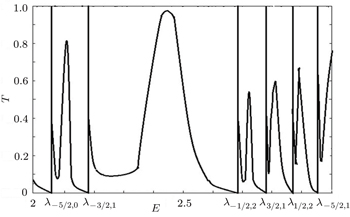† Corresponding author. E-mail:
Project partially financially supported by the Funds from the Government of the Russian Federation (Grant No. 074-U01), the Funds from the Ministry of Education and Science of the Russian Federation (GOSZADANIE 2014/190) (Grant Nos. 14.Z50.31.0031 and 1.754.2014/K), and the President Foundation of the Russian Federation (Grant No. MK-5001.2015.1).
An explicitly solvable model for tunnelling of relativistic spinless particles through a sphere is suggested. The model operator is constructed by an operator extensions theory method from the orthogonal sum of the Dirac operators on a semi-axis and on the sphere. The transmission coefficient is obtained. The dependence of the transmission coefficient on the particle energy has a resonant character. One observes pairs of the Breit–Wigner and the Fano resonances. It correlates with the corresponding results for a non-relativistic particle.
Tunnelling through a nanostructure is an interesting physical phenomenon closely related with the properties of the nanostructure in question. From the first side, it allows one to investigate the characteristics of the nanostructure using the tunnelling as an instrument.[1] From the other side, it creates an opportunity to construct new nanoelectronic devices based on the tunnelling peculiarities. Electron tunnelling through quantum dots with connected leads is studied, e.g., in Refs. [2], [3], and [4]. Interesting results were obtained for tunneling through periodic arrays of quantum dots.[5,6] An explicitly solvable mathematical model for a description of tunnelling through a nanodevice was suggested in Refs. [7] and [8]. It is based on the theory of self-adjoint extensions of symmetric operators. The model is rather universal and allows one to describe tunnelling through different structures. Due to nanotechnology progress, it is possible now to create curved two-dimensional nanostructures (e.g., fullerene-like structures and metallic nanospheres). The above mentioned model is appropriate to describe tunnelling through this structure. Namely, tunnelling of a non-relativistic electron through a sphere with attached semi-infinite leads was studied in Ref. [9]. An explicitly solvable model for the analogous problem dealing with the sphere in a magnetic field was constructed and investigated in Ref. [10]. In the present paper we study tunnelling of a relativistic electron through a sphere with attached leads. We consider the Dirac operator on the semi-axis and the sphere and construct a model based on the operator extensions theory.
Through the present paper we consider the sphere S with two attached wires ℝ+ and ℝ−. The behavior of a relativistic spinless particle is described by the Dirac operator. It has the following form (see, e.g., Refs. [11] and [12]):




The starting operator for our model is the direct sum of the operators described above


To switch on an interaction between parts of our system, we construct the model operator in the framework of the theory of self-adjoint extensions of symmetric operators. Namely, we use the so-called “restriction-extension” method (see, e.g., Refs. [13], [14], and [15]). We denote the restriction of the operator H± by D± and the restriction of HS by DS.
The Hamiltonian of the system is constructed as a self-adjoint extension of the operator

To describe these extensions, we use the Krein formula for resolvents (see, e.g., Refs. [13], [15], and [16]

The Green function for the Dirac operator on the half-line is known[17]


The expression for the Green function of the Dirac operator on the sphere is obtained in Appendix A.
To construct the extensions by formula (


The Krein Q-matrix for the model operator has the form




Further, we consider the scattering problem. Let us take the incoming wave in ℝ− in the form


After straightforward algebraic manipulations, one obtains the following formula for the transmission coefficient T(z) = |t(z)|,

The dependence of the transmission coefficient on energy is shown in Fig. 



 | Fig. 1. Dependence of the transmission coefficient on energy; T is dimensionless, E is in atomic units, i.e., we assume c = ħ = 1, M = 1/2. Eigenvalues corresponding to Fano resonances are marked. |
Fano resonances are characterized by a closely spaced zero and a peak of the transmission coefficient. They are associated with the interference between the localized states of a discrete spectrum and propagating electron waves. As for the position of the resonance, formula (
| 1 | |
| 2 | |
| 3 | |
| 4 | |
| 5 | |
| 6 | |
| 7 | |
| 8 | |
| 9 | |
| 10 | |
| 11 | |
| 12 | |
| 13 | |
| 14 | |
| 15 | |
| 16 | |
| 17 | |
| 18 |


